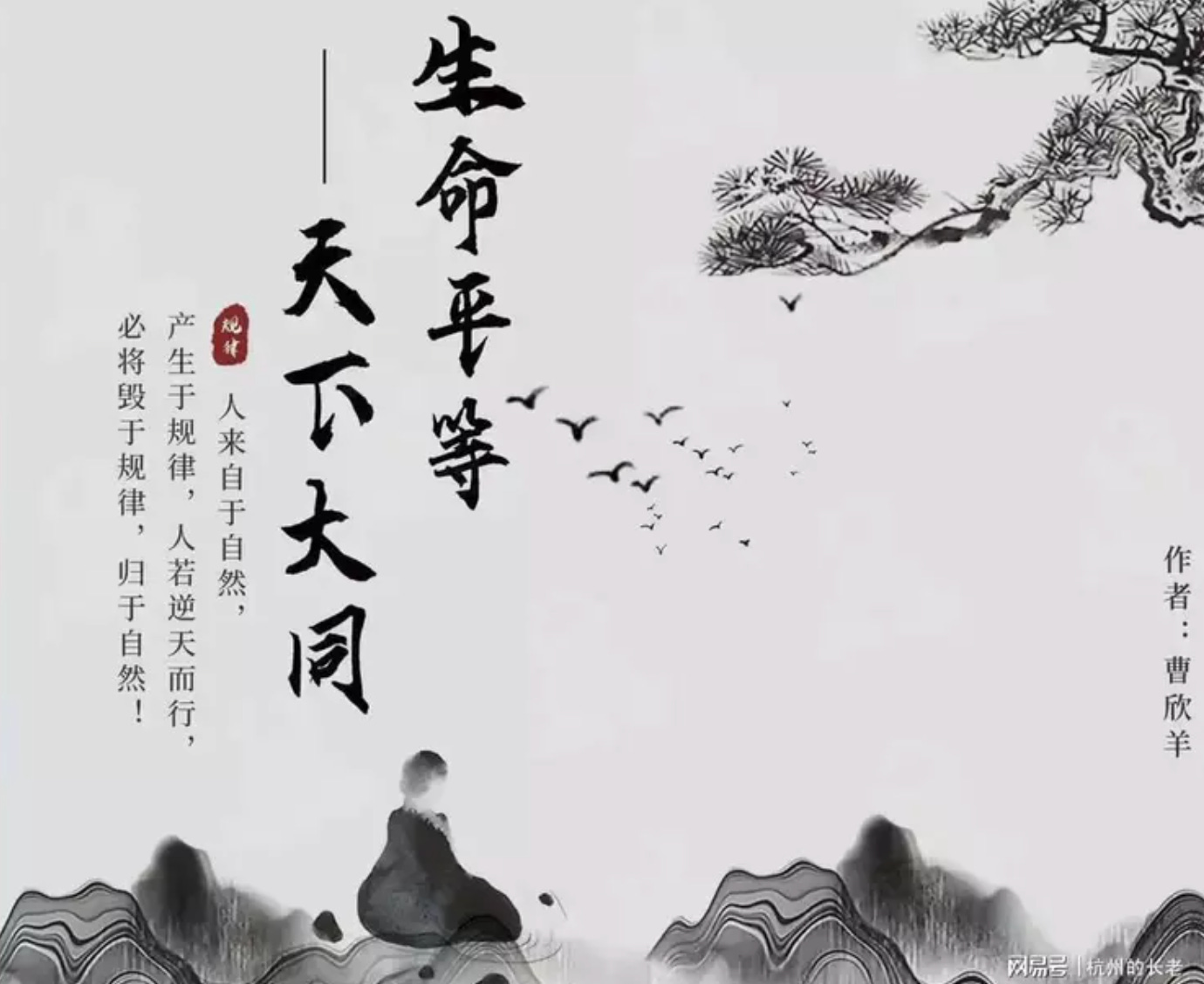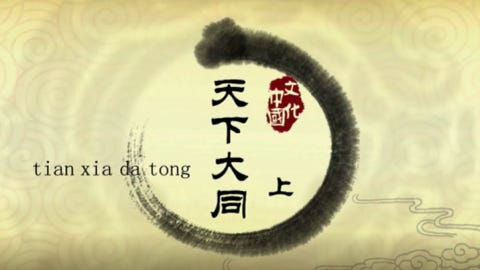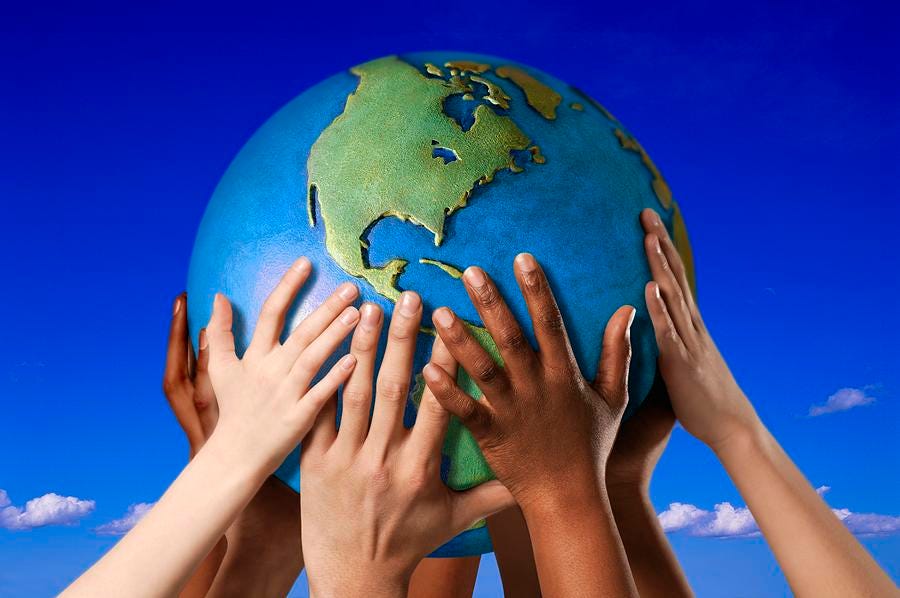National treasures in China are passed down from dynasty to dynasty. When I was studying to become a docent at the National Palace Museum in Taipei, the very first topic we discussed was the cultural significance of the visual arts.
There were four interrelated themes throughout:
a cyclical view of history
the Confucian discourse on art
the social function of art
possessing the past
The last theme of possessing that past was most interesting as it refers both to imperial China's possession of its past through the art of collecting and to the broader cultural tradition of embracing change through the creative reinterpretation of the past.
Embracing change through reinterpretation of the past even runs through China’s political ideology.
From studying classical Chinese history, one can see there is a continuity in Chinese thinking for centuries.
Many people outside of China are not aware of this.
Let’s look at the phrase 天下大同 (tiān xià dà tóng)
天下 = all under heaven
大同 = the great harmony
大同 (dà tóng) is a utopian vision of the ideal world: a world of peace and harmony, where prosperity and joy prevail. It was first recorded in the 禮運 Lǐ yùn chapter of the Book of Rites 礼记 (lǐ jì) by Confucius. The basic feature is that everyone loves and helps each other, every family lives and works in peace and contentment, there is no difference, and there is no war. Everything is at peace. This state is called "the great unity”.
天下 (tiān xià) literally means ‘all under heaven"‘. But it means so much more that that. It is a complex and constantly-evolving concept. During the Eastern Zhou (771-256 BCE), tianxia had a territorial meaning; it represented a land mass of many countries governed by the “Son of Heaven” (天子, tiānzǐ). Later during the same period, tianxia became institutionalized moving from being a political vision to a system of government.
This system is defined by 3 elements:
the tianxia system must ensure that all states involved receive more benefits through their participation than remaining independent
the system is based on mutual dependence and reciprocity between all states
the tianxia must develop a common set of interests, benefits, and commitments to ensure its universally shared character
天下大同 (tiān xià dà tóng) ideology goes way back to the ancient Zhou Dynasty (1046 BC – 256 BC). Confucius writes about this idea of great harmony as an antidote to war, pestilence and banditry. When this state of harmony is reached, no one needs to lock their doors because everyone is watching out for each other, there is a sense of building of a real community.
On a larger scale, the ancient Chinese ideal form of governance is to arrive at a utopia where everyone is equal, the poor, the elderly, and the young are taken care of and every man and woman will find their place in society.
This is 天下大同 (tiān xià dà tóng) - a world of great unity with common good for all
Dating back 2500 years, these ideals of governance have been woven into political thinking in China.
In the early days of modern China this idea was incorporated into the new tenets of communism and tweaked to fit into existing Chinese characteristics. Inspired by the writings of Kang Youwei, Sun Yat Sen used this concept with the phrase 天下为公 (tiānxià wèi gōng) - the world belongs to all.
Kang Youwei 康有为 (1858-1827), a Confucian reformer and a key figure behind the Hundred Days’ Reform (百日维新, bǎirì wéixīn) in 1898, looked to the Confucius classics. He wrote the Book of Great Unity (大同书, dàtóng shū), which was posthumously published in 1935, in which he divided the world’s development into three stages: an “uncivilized” stage, an intermediate or xiaokang (小康, xiǎokāng) stage, and the final stage of great unity (太平世, tàipíng shì). According to Kang Youwei, who supported the restoration of the monarchy but rejected the Western nation-state model, the highest goal was the abolishment of states and inequality, creating a world in common by all (天下为公, tiānxià wèigōng)
天下为公 (tiānxià wèi gōng) - the world belongs to all
It can be said that the ideal Chinese society of 天下大同 (tiān xià dà tóng) lines up to match the Communist idea of utopia, the mutual dependence between the flourishing of the individual and the flourishing of the group. In a way the two ideologies merged.
Since Mao’s death in 1976, there have been many shifts in policy, most notably Deng Xiaoping Theory, Three Represents (Jiang Zemin), Scientific Outlook on Development (Hu Jintao), and Xi Jinping Thought. As I mentioned before, embracing change through reinterpretation of the past runs through China’s political ideology. The 1949 form of communism has morphed into something very different today.
We now commonly hear the phrase - “socialism with Chinese characteristics” 中国特色社会主义 (zhōngguó tèsè shèhuì zhǔyì) - is a set of political theories and policies of the CPC that are seen as representing Marxism-Leninism adapted to Chinese circumstances and specific time periods.
Building a community of common destiny for mankind is the overall goal of China's foreign affairs work in the new era and requires a “new type of international relations.”
It is clear that the Chinese diplomacy we now see on the world stage is an attempt to achieve 天下大同 (tiān xià dà tóng) - a world of great unity. The recent China brokered peace deal between Saudi and Iran is one such example.
Chinese Foreign Minister Wang Yi used the phrase at the 2020. He said:
Xi Jinping Thought on Diplomacy puts the development of China in the global context, and aligns the interests of the Chinese people with the common, fundamental interests of people across the world. It envisions a community with a shared future for mankind, and an open, inclusive, clean and beautiful world with lasting peace, universal security and common prosperity, and calls for a new type of international relations featuring mutual respect, fairness, justice and win-win cooperation.
This is a very powerful ideal. It is ultimately the common good for all humanity, for all under heaven.
There is no China in this, this a wish for global harmony.
There is a phrase first used by former General Secretary Hu Jintao (in office 2002-2012) and has been frequently cited by Xi Jinping - 人类命运共同体 (rén lèi mìng yùn gòngtóngtǐ) officially translated as community with a shared future for mankind or human community with a shared future, and is used to describe a stated foreign-policy goal of the PRC.
Originally the phrase referred to shared blood and common destiny of mainland China and Taiwan. Hu later broadened the expression by adding “for all mankind” to emphasize that "mankind has only one earth to live on, and countries have only one world to share" and called for the building of a “harmonious world of enduring peace and common prosperity.” Hu envisioned a new type of more equitable and balanced global development partnership that would stick together in times of difficulty, both sharing rights and shouldering obligations, and boosting the common interests of mankind.
Again, a shared future for mankind 天下大同 (tiān xià dà tóng).
The current vision, laid out by the government for its domestic policy, is “common prosperity” 共同富裕 (gòngtóng fùyù), and for the world is a “a community with a shared future for humanity” 人类命运共同体 (rénlèi mìngyùn gòngtóngtǐ), both sharing strong associations with the spirit embodied by the Confucian – and communist – vision of a world in great unity 天下大同 (tiānxià dàtóng).
Both political visions point toward a more just world in which the wealth of tianxia is more evenly shared among its inhabitants, between the North and South, the developed and the underdeveloped countries, the rich and the poor.
天下大同 (tiānxià dàtóng) is a concept for common good that is without borders.
It is a universal concept.
It is a message that needs to be amplified.
Reference article from Dongsheng News HERE
Read Wang Yi’s 2020 speech at the Inauguration Ceremony of The Xi Jinping Thought on Diplomacy Studies Centre HERE








